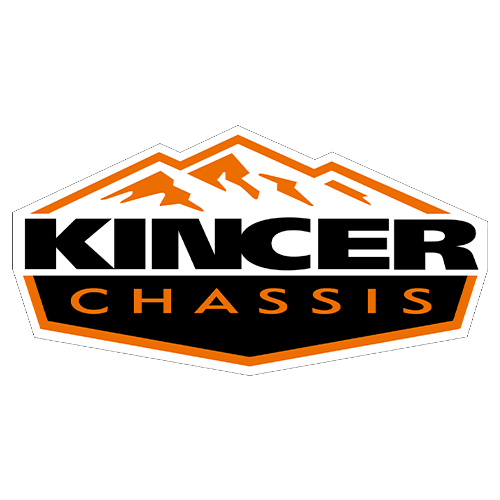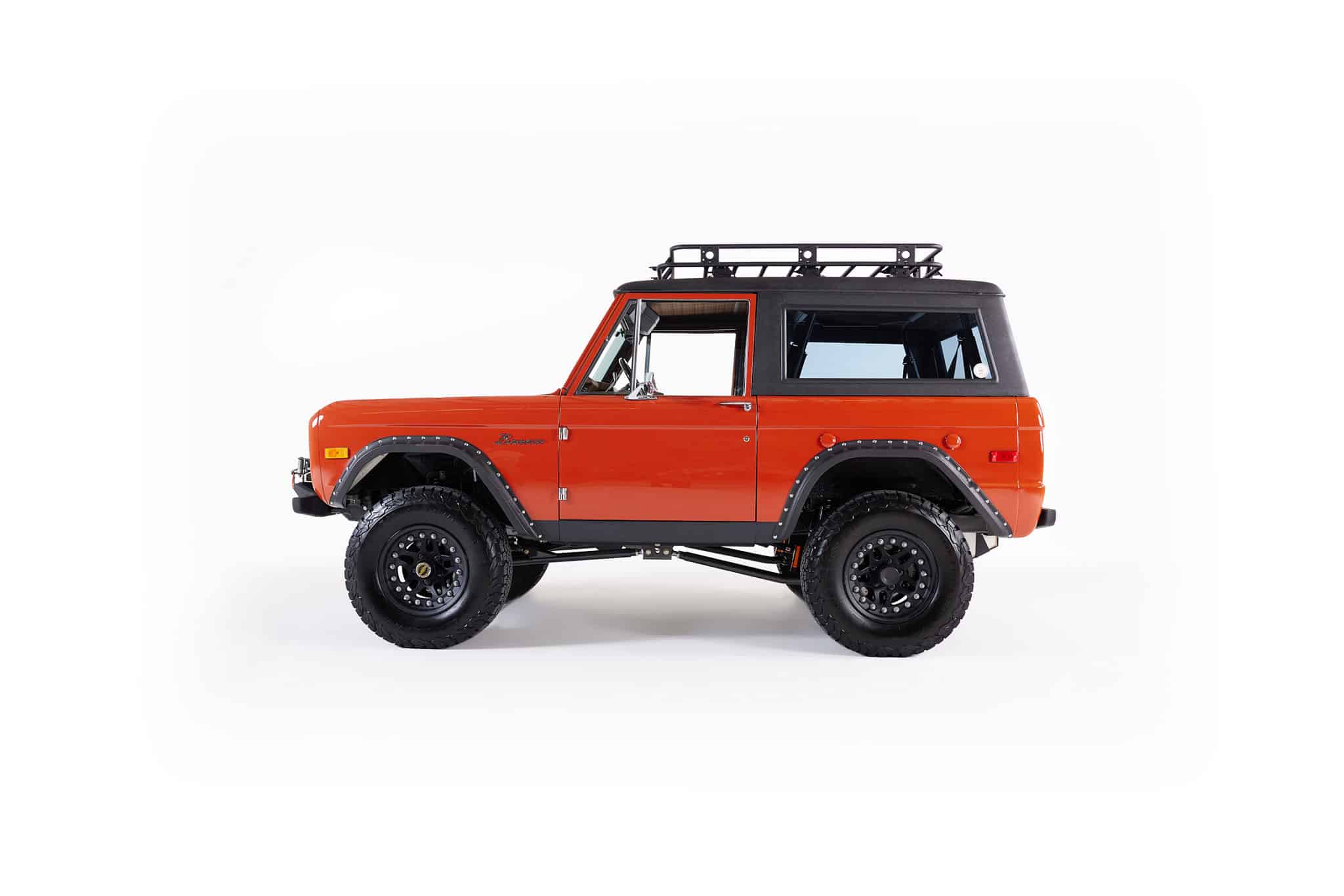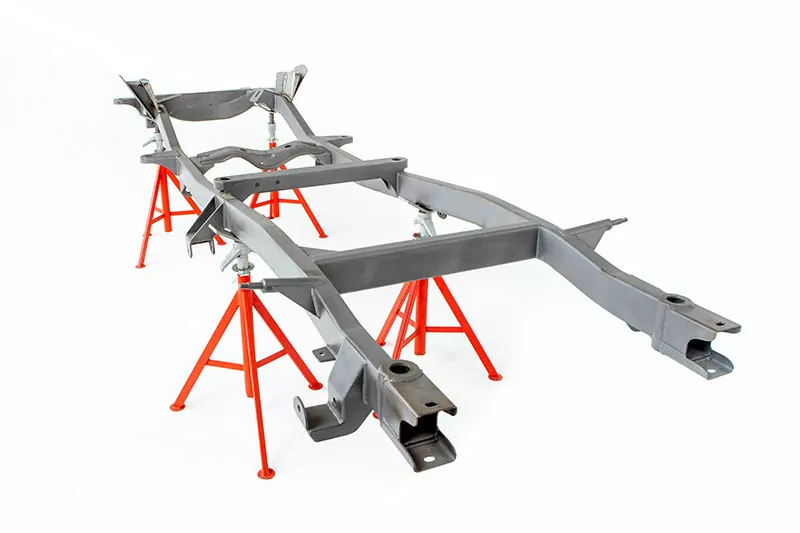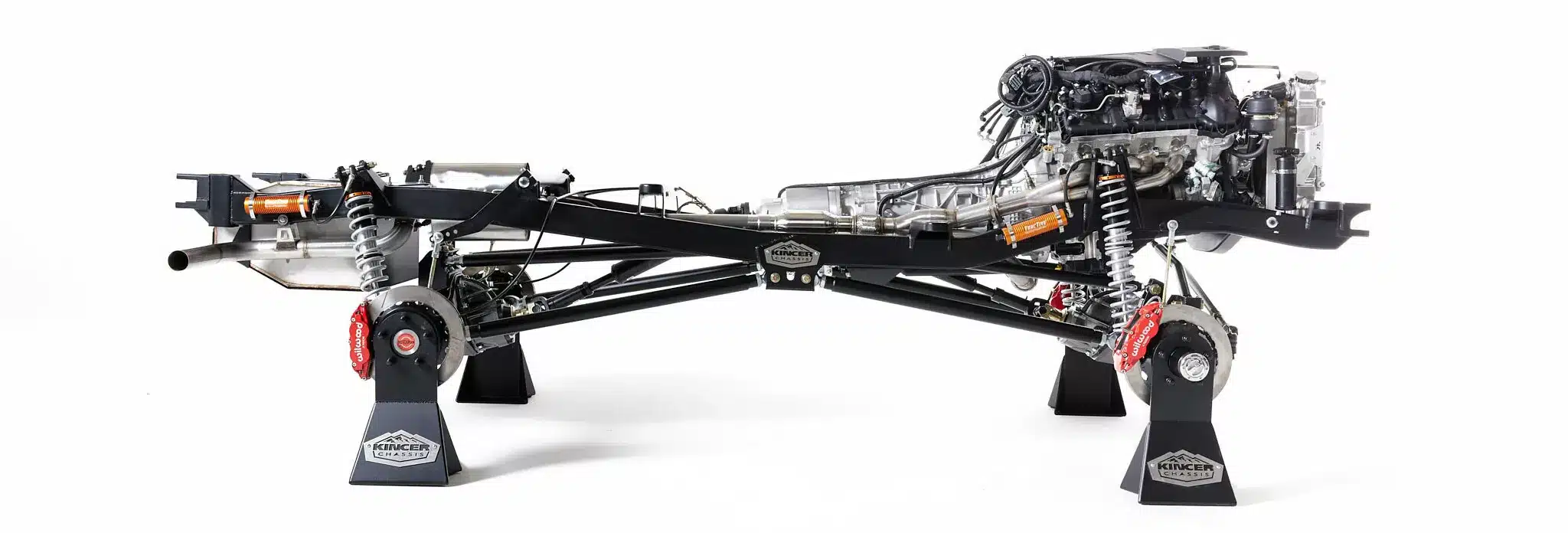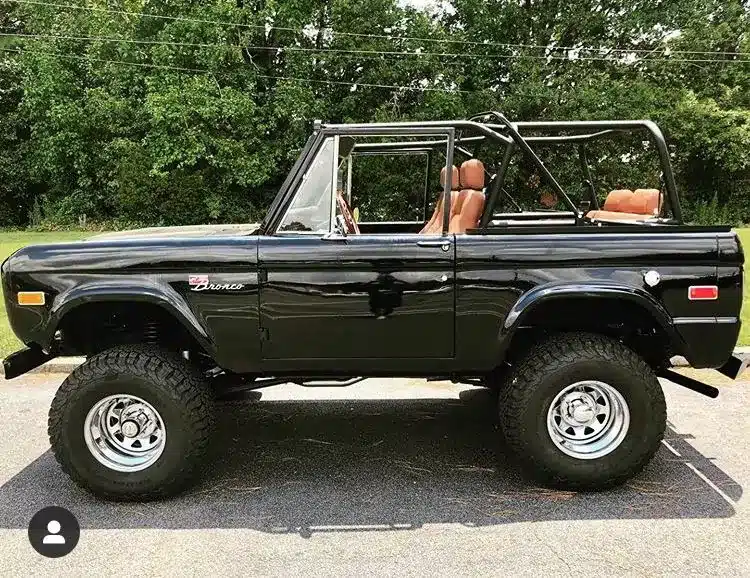The Classic Ford Bronco: A Vintage Off-Road Legend
The Classic Ford Bronco is an iconic piece of American automotive history. Introduced in 1966, this multi-purpose vehicle quickly became a favorite among off-road enthusiasts and classic car collectors alike. Its rugged design, combined with its versatility, made it an instant classic. Over the years, the Bronco has evolved, but its spirit of adventure remains the same.
That’s why we at Kincer Chassis put so much care and effort into what we do. You have a dream of the life you want to live in your classic Ford Bronco and we want to make that dream a reality! Let’s get to work!
The History of The Ford Bronco – The First Generation Bronco
A classic Ford Bronco is considered to be one built between the model year 1966-1977!
The first gen started with the 1966 Ford Bronco and it was released in three versions or “body styles”. You can read more straight from Ford on the history of the Bronco.
ROADSTER
The quintessential Bronco Roadster is a multi-use vehicle that comes standard without a roof or doors, delivering a rugged and adventurous feel. Its sleekly shaped door openings contribute to a sporty aesthetic. For those seeking additional protection or a different look, optional steel doors can be added, with or without glass and a frame. A vinyl top coupled with matching vinyl doors is another customizable feature. Unique to the Roadster, the windshield can be conveniently folded down and secured onto the hood.
The interior of these body styles offers a standard bench seat, comfortably accommodating up to three passengers. For a more personalized seating arrangement, one or two front bucket seats can be chosen as an optional feature. If this Ford offered option was selected, it was necessary to also opt for the rear bench seat. A standard steel partition separates the front and rear spaces but is omitted if the rear seat option is selected.
SPORTS UTILITY
The Sports Utility Vehicle model shares the foundational characteristics of the standard Roadster but adds several enhancements for weather protection and convenience. It features a short steel roof, metal side doors, and roll-up windows, ensuring a cozy, shielded interior.
Like the Roadster and Wagon, the Sports Utility model is equipped with a full-width 56-inch tailgate that includes a user-friendly, single-handed latch. The wheel housings are designed with flat tops for added utility. The vehicle’s standard seating arrangement includes a full-width bench-type front seat, with the option to add one or two front bucket seats for a more tailored setup.
One of the standout features of the Ford Bronco Sports Utility model is its sturdy yet lightweight steel roof, weighing just 70 pounds and capable of being unbolted and removed at the owner’s discretion. The rear area, defined by its double-walled design, boasts more than 32 square feet of storage space, perfect for camping equipment or other outdoor gear.
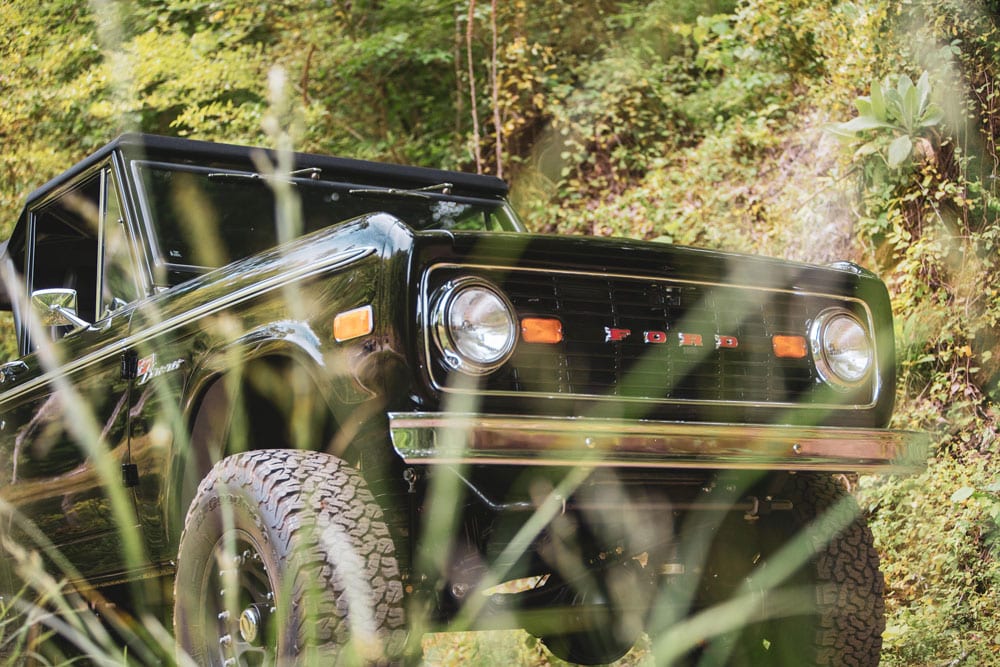
WAGON
The Bronco Wagon model builds upon the basic body of the Bronco, adding a full-length roof and upper body sides for an encapsulated and secure feel. Both driver and passenger doors are made of steel and equipped with roll-up windows. Additional large fixed windows are installed on the upper body sides, and a rear liftgate window can be locked open for ventilation.
The tailgate can be oriented horizontally to accommodate long items, and the entire enclosed area of the Wagon model can be fully locked for added security. If desired, the top and upper body sides can be unbolted and removed, allowing for more open-air exposure.
The standard seating arrangement can be modified to include front bucket seats, which are required if the optional bench-type rear seat is chosen. If the back seat option is selected, the steel bulkhead is omitted, providing a more open and spacious interior.
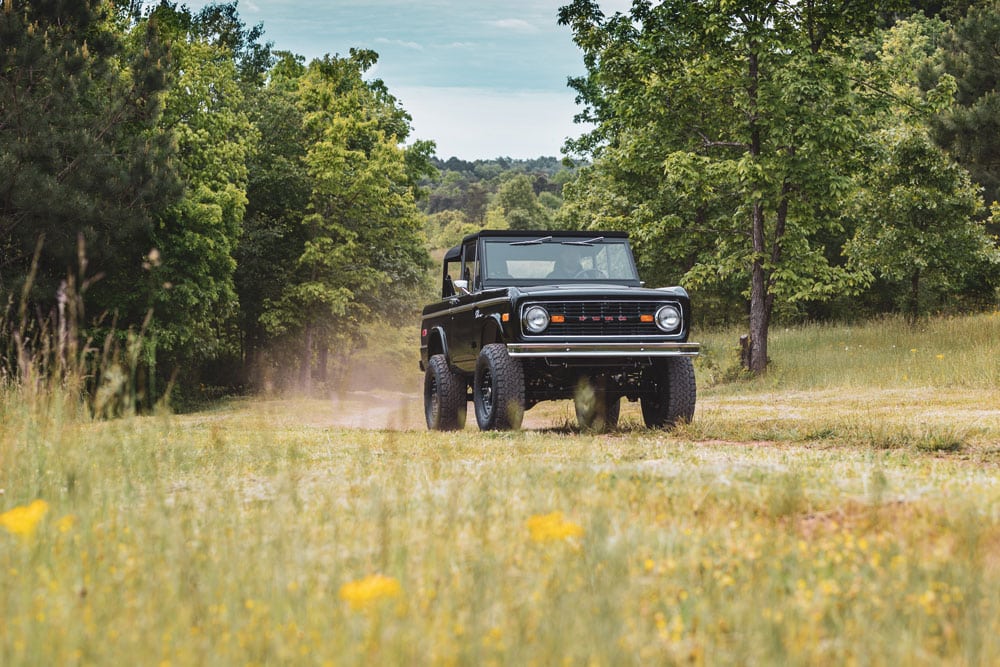
The End of the Early Bronco Era
Ford stopped production of the early Bronco in 1977 and that was the end of the Classic Bronco Era. The first generation 1966 1977 Bronco days were over. The decision was driven by a desire to compete with larger SUVs like the Chevrolet Blazer. As a result, the second-generation Bronco was introduced in 1978 and was significantly larger than its predecessor. Despite this change in direction, the early Bronco’s legacy lives on, with its classic design and off-road vehicle capabilities still cherished by fans today.
The Most Desirable Year for Vintage Broncos
When it comes to the most desirable year for the Ford Bronco, many enthusiasts point to the 1977 model year. This was the last year of the first-gen Broncos, and it perfectly blends classic style with modern features.
While the best Bronco model year is subjective, the 1977 Bronco marked a significant step forward in terms of comfort and drivability, with power steering and front disc brakes becoming standard. These features, combined with the Bronco’s timeless design, make the 1977 model a standout choice for collectors and enthusiasts alike.

The Rarity of Classic Broncos for Sale
Classic Broncos are relatively rare, and there’s a simple reason for this: many of these vehicles were used for what they were built for—off-roading, daily driving, and farm use. Unfortunately, not all of them survived these rugged conditions. Others were not preserved or maintained, further reducing the number of these vehicles that are still on the road today. This rarity, combined with the Bronco’s enduring popularity, makes finding a classic Bronco in good condition a rare and exciting event.
That’s one reason so many people come to us at Kincer Chassis. They’ve found a Bronco but it doesn’t run or handle as well as they’d like and maybe the frame is rusted. We work hard to make it simple for you to get that barn-find Bronco back on the road with our chassis!
The Value of an Old Ford Bronco
Is an old Bronco worth it? Do Classic Ford Broncos hold their value? Is a vintage Ford Bronco a good investment? The answer to all three questions is a resounding yes.
Classic Broncos, especially those in good condition or those that have been restored, are considered valuable. They have a strong following, which helps maintain their value over time. Furthermore, the Bronco’s iconic status and its rarity mean that well-preserved models often fetch high prices on the collector’s market.
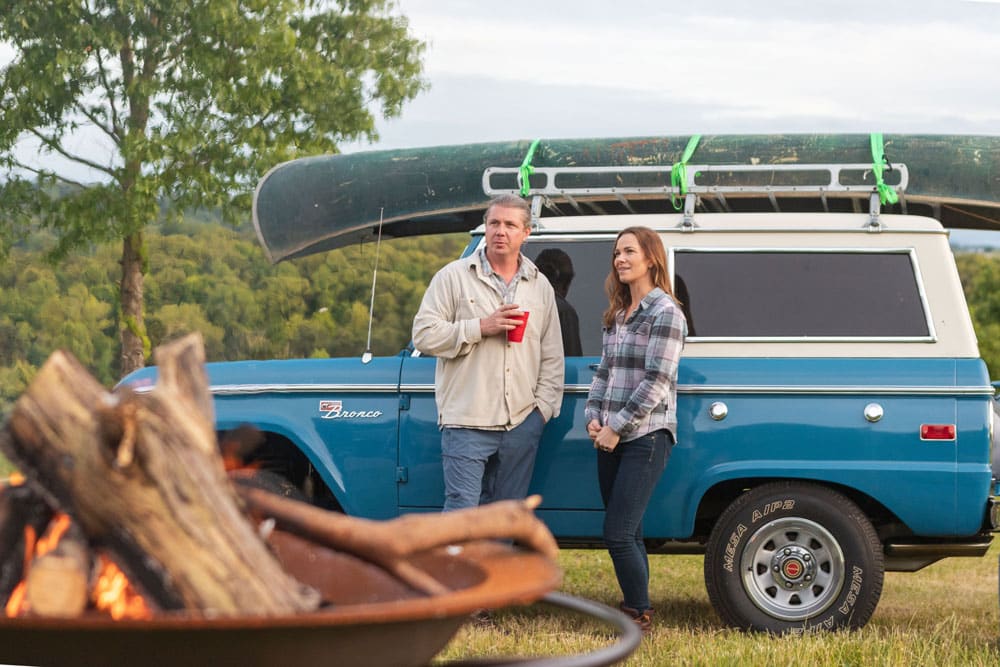
Buying a Classic Bronco: What to Look For in a Classic Bronco For Sale
If you’re considering buying a classic Bronco, there are a few key things to look for no matter if you’re buying privately or bidding on your Bronco at an auction. First and foremost, check for rust. The Bronco’s body is prone to rust, especially in the rear quarter panels and floor pans.
Also, ensure the frame is straight and free from significant rust or damage. Verify the condition of the engine and manual or three-speed automatic transmission, and look for signs of regular maintenance. It’s also a good idea to take it for a test drive to see how it handles and listen for any unusual noises.
Here’s a list of 10 things to look for when buying a Ford Bronco:
- Rust: Check for rust, in the quarter panels, floor pans, and frame. These are common areas where rust can develop.
- Frame Condition: Ensure the frame is straight and free from significant rust or damage. A damaged frame can lead to serious issues down the line.
- Engine Condition: Listen for any unusual noises when the engine is running. Check for leaks and ask about the last time major components like the timing belt were replaced.
- Transmission Condition: Whether it’s a manual or automatic transmission, it should shift smoothly without any grinding or jerking.
- Maintenance Records: A well-maintained Bronco is likely to have fewer issues. Ask for maintenance records to see how well the vehicle has been taken care of.
- Original Parts: While not a deal-breaker, Broncos with original parts or period-correct restorations tend to hold their value better. There are plenty of aftermarket parts that can upgrade your Bronco while maintaining the original Bronco appeal.
- Interior Condition: Check the condition of the seats, dashboard, and other interior components. These can be expensive to replace or restore.
- Electrical System: Test the lights, horn, wipers, and any other electronic components to ensure they’re working properly.
- Driveability: Take the Bronco for a test drive. It should handle well, brake effectively, and not make any strange noises. If it doesn’t drive, know that it can be fixed, but it will take some time and hard work. Or you could upgrade to a new chassis with a powertrain from Kincer Chassis!
- Price: Compare the asking price with the market value of similar Broncos in similar condition. Don’t be afraid to negotiate.
Remember, it’s always a good idea to have a trusted mechanic inspect the vehicle before you buy. They can help identify potential issues that you may not notice.
Transmissions in the Early Ford Bronco
Early Broncos came with a variety of transmissions. From 1966 to 1972, Ford made the standard transmission a three-speed manual transmission, known as the “three on the tree.” In 1973, Ford introduced an optional three-speed automatic transmission, which became increasingly popular with consumers. Regardless of the type, ensure the transmission in your potential Bronco is in good working order.
Classic Ford Broncos Power Steering and Air Conditioning
Power steering was introduced as an option in 1973 and became standard in 1976, making the Bronco much easier to handle. Air conditioning, however, was never a factory option in the first-generation Bronco, but it was commonly added as an aftermarket upgrade. If air conditioning is a must-have for you, be sure to check if the vintage Broncos you’re considering have this upgrade or begin looking into aftermarket options
Working on Old Broncos
At Kincer Chassis, we love classic Broncos just like you do! These old-school trucks are not just cool to look at, but they’re also simple and fun to work on. Unlike new cars that have lots of complicated electronic parts, old Broncos are straightforward and user-friendly. That’s what makes them so great for people who like to roll up their sleeves and get their hands a little dirty.
But the best thing about Broncos? You can make them your own! With the help of our friends at Krawlers Edge, we can give you everything you need to customize your Bronco just the way you want it. Need some new parts like an upgraded fuel tank? No problem. Want to beef up your Bronco’s frame strength, handling, or power? We’ve got you covered.
One of the most exciting transformations you can embark on is the Coyote Swap—an engine conversion that replaces the Bronco’s original power plant with the modern 5.0-liter Coyote Engine. This engine, known for its balance of power and efficiency, breathes new life into the classic Bronco, merging the charm of yesteryears with the performance of today. The Coyote Engine delivers impressive horsepower and torque, providing a significant performance boost while maintaining the Bronco’s signature off-road capabilities.
At Kincer Chassis and Krawlers Edge, we understand that undertaking a Coyote Swap can seem daunting. That’s why we offer comprehensive support to make the process as seamless as possible. We can supply a new 5.0-liter Coyote Engine directly to you, along with all the necessary parts for the swap. Moreover, our team of experts is always ready to provide guidance and answer any questions you may have, ensuring your Bronco transformation is a seamless experience from start to finish.
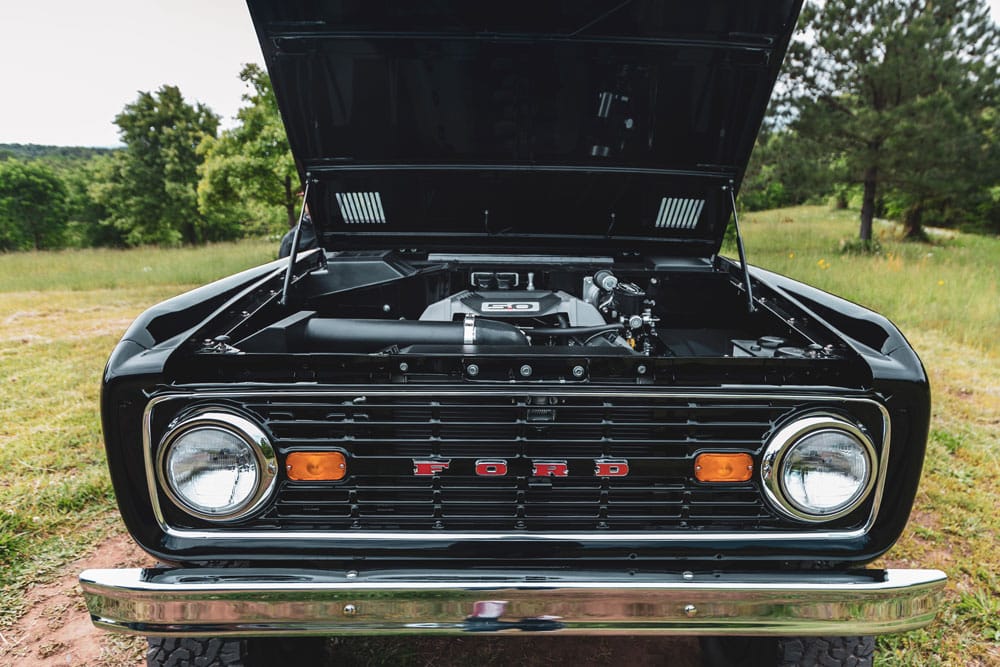
Gas Mileage of the Ford Bronco
When it comes to gas mileage, the classic Bronco isn’t going to win any awards. These vehicles were designed for performance and durability, not fuel efficiency. However, the exact mileage can vary greatly depending on the condition of the vehicle and the driving conditions. On average, you can expect a classic Bronco with the small block V8 to get between 8 to 15 miles per gallon.
Ford introduced an auxiliary gas tank option in 1967 and that was a big hit for those looking to go further in their off-road vehicles.
We love the 23-gallon stainless steel fuel tank from Krawlers Edge. This fully assembled tank is a breeze to install and gives you great peace of mind when you’re restoring your Bronco.
Cost of a Restored Bronco vs. DIY Restoration
Purchasing a restored Bronco can be quite expensive due to the labor and expertise involved in the restoration process. There are not many vintage Ford Broncos out there on a deep discount sale. Depending on the quality of the restoration and the original condition of the vehicle, prices can range from $30,000 for something you might find on Facebook Marketplace to over $300,000.
On the other hand, restoring a Bronco yourself can be a cheaper option, but it requires a significant time investment along with mechanical knowledge. Plus, the cost of parts and potential specialist work must be factored in.
Factors that Impact What a Classic Bronco Costs
Condition! The condition the Bronco is in will definitely impact the price. You’re not going to find many out there for sale cheap. In fact, we’ve written an entire article on how much does an old Ford Bronco cost? That articles goes into how the features and options offered can affect the price as well as how the location impacts the costs as well.
Replacing Your Ford Bronco Frame: Get a Better Build using Kincer Chassis Custom Early Bronco Frames
If your classic Bronco needs a new frame, don’t worry – we have excellent options available. Our frame is known to be the highest-quality custom early Bronco frame you can buy.
At Kincer Chassis we offer fully boxed, mandrel-bent frames that provide a strong and sturdy base for your Bronco. Our frames are specially designed to fit the original body with no modifications, and your OEM suspension will bolt right up making it an excellent choice for restoration projects.
Sound like something you’re interested in but not sure you’re up for doing the work yourself? Check out our rolling chassis.
Upgrading with a Kincer Chassis Coil Over Rolling Chassis
For those looking to build, restore, or upgrade their classic Bronco, our USA-made Adventure Series Coil-Over Early Bronco Rolling Chassis is the most popular choice. This chassis offers a modern touch to the classic Bronco and vastly improves its performance and drivability.
Starting with our award-winning frame – this chassis features adjustable coil-over shocks that offer improved ride quality and handling compared to the original leaf spring suspension. The chassis also comes with a power steering box and four-wheel disc brakes, enhancing your Bronco driving experience.
One of the key advantages of a Kincer Chassis is its compatibility with modern Ford powertrain options, including the Coyote 5.0 engine,10R80 transmission, and Atlas transfer case. This allows you to enjoy the power and efficiency of modern technology while retaining the classic Bronco look.
Whether you’re planning a full restoration or a simple upgrade, the Kincer Chassis Coil Over Rolling Chassis offers a blend of classic style and modern performance that can bring your classic Bronco into the 21st century. Match our chassis with the Ford Bronco Tub from Dennis Carpenter and you’ll have the ultimate of all classics!
Contact us if you have any questions! We’ll help you get the Bronco build you’ve always wanted.
What are the Bronco generations?
- First Generation Bronco (1966-1977): This is the original “classic” Bronco, often referred to as the “Early Bronco”. It was introduced in 1966 as a competitor to the small four-wheel-drive compact SUV. It came in three body styles: the Roadster, Sports Utility, and Wagon.
- Second Generation Bronco (1978-1979): The second-generation Bronco was a major redesign, moving to a larger size. It was based on the F-100 pickup truck and was only produced for two years.
- Third Generation Bronco (1980-1986): The third-generation Bronco saw a move to a more aerodynamic style, and it was based on the F-Series pickup truck. They got rid of the solid front axle and replaced it with an independent front suspension system. It was during this third generation that they introduced the Bronco II as a smaller alternative, which was produced from 1984 to 1990. The 1984 Ford Bronco II was the first year of the Eddie Bauer Edition, named after the outdoor gear company. The 1985 Bronco was the first to feature the Eddie Bauer trims package.
- Fourth Generation Bronco (1987-1991): The fourth-generation Bronco received another redesign with more aerodynamic lines, fuel injection, and a rear antilock braking system.
- Fifth Generation Bronco (1992-1996): The fifth-generation Bronco is the most recognized, largely due to the infamous O.J. Simpson car chase in 1994. This generation saw further improvements in comfort and safety features.
- Sixth Generation Bronco (2021-): After a long hiatus, Ford reintroduced the new Bronco for the 2021 model year. The new Bronco in the Ford lineup takes inspiration from the first-gen design while integrating modern technology and features including a ten-speed automatic transmission, removable hardtop, four-door version with plenty of room for rear passengers, and spare tire. It competes with the Jeep Wrangler and comes in two versions: a smaller Bronco Sport, and a larger model simply called the Bronco and comes in both a two and four-door model.
Are all Broncos Four Wheel Drive?
Yes, all generations of the Ford Bronco, from the first-gen Bronco introduced in 1966 to the sixth generation reintroduced in 2021, have been equipped with a four-wheel drive system (4WD) as a standard feature. The Bronco was designed to be a rugged, off-road vehicle, and four-wheel drive is a critical feature that supports this capability.
That being said, some models and configurations may offer different types of 4WD systems, or additional off-road features and options. For example, the latest generation of the new Bronco introduced in 2021 offers both a part-time four-wheel drive system and an advanced four-wheel drive system with an automatic on-demand engagement feature, depending on the chosen model and package.
What engines came in the Classic Broncos?
The first-generation Ford Bronco, produced from 1966 to 1977, came with three different engine options:
- 170 CID Inline Six: The base engine for the 1966 model year was a 170 cubic inch (2.8 L) straight-six, the same engine used in the Ford Falcon and the early Ford Mustang. This engine produced 105 horsepower and 158 lb-ft of torque.
- 200 CID Inline Six: In 1973, Ford replaced the 170 CID engine with a larger 200 cubic inch (3.3 L) straight-six. This engine produced 84 horsepower and 190 lb-ft of torque. The decrease in horsepower compared to the 170 CID engine was primarily due to changes in the way horsepower was measured and reported in the early 1970s.
- 289 CID V8 and 302 CID V8: Starting in late 1966, Ford began offering a 289 cubic inch (4.7 L) V8 as an option. This engine produced 200 horsepower and 282 lb-ft of torque. In 1969, the 289 was replaced with a 302 cubic inch (4.9 L) V8. The 302 engine produced 205 horsepower and 300 lb-ft of torque.
What Bronco is the half-cab pickup?
The “Half Cab” Bronco refers to a specific configuration of the first-generation Ford Bronco (1966-1977) that had a pickup-style design.
In this configuration, the Bronco had a small, enclosed cab for the driver and one passenger, and an open pickup bed in the back. This style of Bronco was often referred to as a “Half Cab” or Bronco Pickup because the cab did not extend the full length of the vehicle like the standard wagon-style Bronco. The roof over the cab was a removable hardtop! Now we’re talking fun.
The Bronco Half-Cab was one of the three body styles offered for the early Bronco, along with the Roadster and the Wagon. It was less popular than the other styles and was discontinued before the end of the first-gen Bronco’s production run.
The Vintage Half-Cab Bronco in the photo below features a Krawlers Edge Early Bronco Sport Cage!

The Ford Bronco on TV and in The Movies
The Ford Bronco isn’t just a favorite among car enthusiasts; it’s also a star of the silver screen. The Bronco’s rugged charm and all-American appeal have made it a popular choice for TV shows and movies.
Perhaps the most famous appearance of the Bronco is in the classic TV series, “The Dukes of Hazzard.” While the show is best known for the General Lee, a 1969 Dodge Charger, a 1970 Ford Bronco also made several appearances throughout the series.
The Bronco has also been featured in a number of films. In “Walking Tall” (2004), Dwayne “The Rock” Johnson’s character drives a 1973 Ford Bronco. The 1972 Bronco was featured in the movie “Safe Haven” (2013), and a 1966 model made an appearance in “The Gumball Rally” (1976).
More recently, a first-gen Bronco was showcased in the hit movie “Top Gun: Maverick.” Perfect for the drive on the beach!
The Ford Bronco’s appearances in popular culture have not only helped to increase its visibility but also its desirability. It’s not just a car; it’s a piece of Americana, a symbol of freedom and adventure that resonates with audiences and car enthusiasts alike.
Conclusion
At Kincer Chassis we understand the classic Ford Bronco is more than just a vehicle—it’s a piece of American history. The first generation Bronco that Ford offered has endured the test of time with an appeal that lies in its rugged design, versatility, and the sense of adventure it inspires. Whether you’re a collector, an off-road enthusiast, or someone who appreciates classic cars, the Bronco has something to offer.
Its unique combination of style, performance, and history make it a truly iconic vehicle.

Visit Us
3707 Louisville Road
Louisville, TN 37777
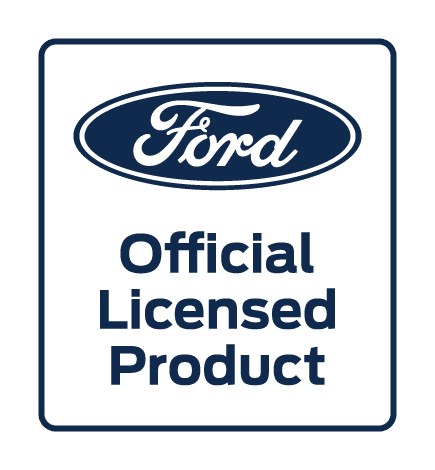
Ford Trademarks and Trade Dress used under license to Kincer Engineering and Design, LLC.
